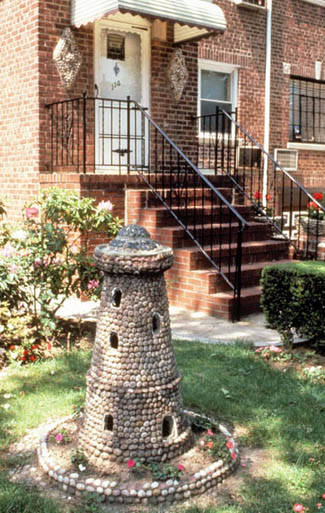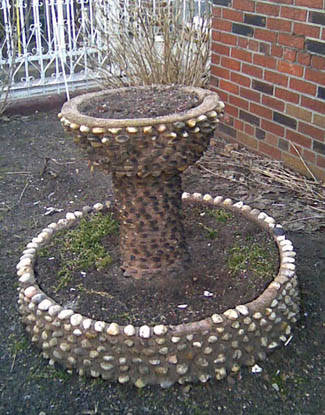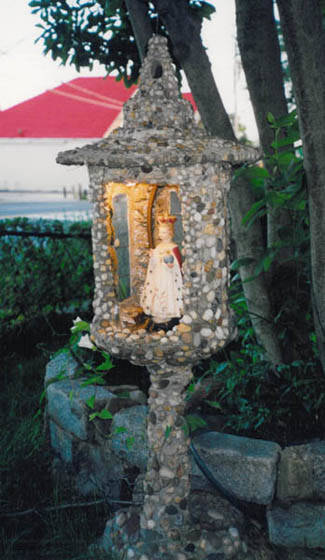The Decorated Flowerpots of Brooklyn
I spent this September looking at and thinking about a little known Italian-American folk art: the pebble and cobble mosaic planters in front of private homes in southern Brooklyn.
As a life-long resident of the borough, I have known these objects for decades. And I have studied the technique as part of my research on Italian-American yard shrines. But I had never focused specifically on these stone-encrusted vessels found in front yards, stoops, and porches. While they exist in neighborhoods with once large Italian-American populations, like Astoria, Queens, and Williamsbridge, the Bronx, I spent time in Dyker Heights and Bensonhurst, Brooklyn, trying to learn more.
I was fortunate to have as my guide Anthony Scotto, who has been an invaluable source of information on Italian-American horticultural and artisan traditions. As he told me in an email:
"Maybe I’m imagining a past here, but I can recall clearly a pebble and cement-filled childhood, a childhood where all surfaces where either pebbles or cement and where the two were united in planter containers across Brooklyn and Queens."
Anthony and I visited five locations:
7005 and 7009 14th Avenue, Dyker Heights
1594 73rd Street, Bensonhurst. One of two rectangular boxes and an urn on a porch.
1077 Bay Ridge Parkway, Dyker Heights.
1611 81st Street, Dyker Heights. One of three houses with decorated planters on the porches, including 1601 81st Street (two rectangular boxes) and 1609 81st Street (two rectangular boxes flanking an urn).
1570 and 1572 80th Street, Dyker Heights.
I wasn’t able to verify the makers of these objects. Neither Michael Miranda and Leung Fong Seto (via his son Simon), the two homeowners on 81st Street that I spoke with, were able to provide any information about their provenance. “They were here when I bought the house,” both men told me.
Genoa, 2009.
These decorated planters emerge out of a centuries-old tradition in the wider Mediterranean, going back to antiquity. Italy is one place where pathways, steps, and gardens are decorated with such pebble mosaics.
(left) Genoa, 2009; (right) Bickleigh Castle, Devon, England,
courtesy Maggy Howarth's The Complete Pebble Mosaic Book (2009).
Italian emigrants brought these aesthetics and skills when they went abroad. While I am still waiting to hear from the Frick Museum if the patterned stone walkways there were created by Italian artisans (a definitive book about the mansion fails to mention the outdoor stonework), we know that Italian POWs held in Devon during World War II took it upon themselves to craft a walkway of local river stones in a scalloped pattern.
Frick Museum, New York City, 2010. Photograph: Leon Read.
While this artisan tradition is not unique to Italy or Italian Americans, in New York City, this art is distinctly Italian American.
Brooklyn yard art: (left) lighthouse, house facade decoration, and planters, 114 Mina Street, Kensington, 1985; (right), nonextant tower, 1235 78th Street, Dyker Heights, 1985. Photograph: Martha Cooper.
It is difficult to date the planters. With the exception of the row houses on 81st Street that were built in 1950, all the houses were built before World War II.
These planters are embedded with what appears to be quartz beach pebbles and cobbles, primarily oval in shape and off-white in color. These may very well be from Long Island. Did the makers cull the city’s beaches to gather their materials? I asked geologist Stanley Schleifer for his input and he graciously offered the following:
It’s hard to tell in the images but the white pebbles are probably quartz. Quartz is next to the hardest mineral commonly found on Long Island and it is the most resistant to weathering. Pebbles as large as the ones shown in your images are not likely to be found on south shore beaches and city beaches such as Rockaway, Brighton Beach, and Coney Island. There the beaches consist almost entirely of sand sized particles. On the north shore the headland beaches are likely to be composed of glacial till which is more likely to contain large pebbles and cobbles. Many of these would be composed of quartz, with the white “milky quartz” variety being the most common. White feldspar pebbles and cobbles would also be a major constituent. Headlands such as Montauk Point and Orient Point would also be expected to contain large pebbles and cobbles. While we can’t know for sure where the pebbles came from without doing a provenance study, the people creating these mosaics would be likely to get their materials from closest (and therefore cheapest) possible source. Excavating and sieving the till in the terminal moraines that run the length of Long Island, and are also found in Staten Island, would also be a good way to get these kinds of pebbles.
Anthony has suggested that the makers most likely obtained the pebbles (as aggregate) from building suppliers or house contractors, in an era before ready-mix.
Walkway trim, 1077 Bay Ridge Parkway, Dyker Heights.
There are a number of design elements that can be found among these examples and others found throughout the city:
horizontal bands outlining edges to create distinct panels or sections,
vertical lines dividing upper and base, in the urns,
circular, oval, and diamond shapes, with the latter being prominent,
the insides of these three shapes may contain a single stone creating a center, a cross (as with the walkway trim), or be filled in either with stones of similar size as those creating the form or with much tinier pebble.
It is in the specific detailing of these common motifs that I believe we can begin to ascertain the individual craftsperson. But it has been, what I assume, to be decades since their creation, and we are far removed from the original makers' identities.
Other Brooklyn planters.
I might have come up with answers and perhaps met the makers had I inquired during the 1980s when I began my research on Italian-American folk arts and vernacular architecture in New York City.
Nonextant house shrine, 108-50 48th Steet, Corona, Queens, 1985.
Photograph: Martha Cooper.
But in 2005, I did meet Vincent Albi, a 87-year-old retired lithographer, who built a yard shrine in 1979 when he bought his corner house across the street from Marine Park, Brooklyn, as a tribute to his Barese immigrant father, Gregorio, who was a stone mason.
(left) 2184 Stewart Street, Marine Park, Brooklyn, 2005; (right), St. Anthony shrine, Rosebank, Staten Island, 2012, Photograph: Christoper Mulé.
Perhaps the most spectacular use of the pebble mosaic technique can be found at the Our Lady of Mt. Carmel Grotto in Rosebank, Staten Island. Hundreds upon hundreds of stones have been embedded in the surface of this structure—along with smaller shrines on the property—that was listed on the National Register of Historic Places in 2000.
Our Lady of Mt. Carmel Grotto, Rosebank, Staten Island, 2012. Photograph: Christoper Mulé.
The grotto was a collaborative effort of members of the Our Lady of Mt. Carmel Society who began working on the structure in 1930s. The masonry work was attributed to Umberto Summa and Angelo Madrazzo. The stones were pressed into sandbox forms into which cement was poured, and when it hardened, the wooden frames were dismantled and the stone‑encrusted sections were removed and secured in place with cement, wire, and/or metal rods.
While we may never know the names of the artisans who created the mosaics on this handful of planters in Brooklyn, their artistry and workmanship continues today. Simon was quick to point out how his Chinese-American immigrant father continues to use the flowerpots, having planted Calamondin oranges in each of the three. The decorated planters are the city’s legacy of Italian-American folk art.
1609 81st Street, Dyker Heights, Brooklyn.










































i-Italy
Facebook
Google+
This work may not be reproduced, in whole or in part, without prior written permission.
Questo lavoro non può essere riprodotto, in tutto o in parte, senza permesso scritto.